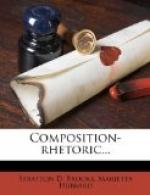+120. The Fundamental Image.+—The first impression of the object as a whole is called the fundamental image. The beginning of a description should cause the reader to form a correct general outline, which will include the main characteristics of the object described. While the fundamental image lacks definiteness and exactness, yet it must be such that it shall not need to be revised as we add the details. If one should begin a description by saying, “Opposite the church there is a large two-story, brick house with a conservatory on the left,” the reader would form at once a mental picture including the essential features of the house. Further statements about the roof, the windows, the doors, the porch, the yard, and the fence, would each add something to the picture until it was complete. The impression with which the reader started would be added to, but not otherwise changed. But if we should conclude the description with the statement, “This house was distinguished from its neighbors by the fact that it was not of the usual rectangular form, but was octagonal in shape,” the reader would find that the image which he had formed would need to be entirely changed. It is evident that if the word octagonal is to appear at all, it must be at the beginning. Care must be taken to place all the words that affect the fundamental image in the sentence that gives the general characteristics of that which we are describing.
Hawthorne begins The House of the Seven Gables as follows:—
Halfway down a by-street of one of our New England towns stands a rusty wooden house, with seven acutely peaked gables, facing towards various points of the compass, and a huge, clustered chimney in the midst. The street is Pyncheon street; the house is the old Pyncheon house; and an elm tree, of wide circumference, rooted before the door, is familiar to every town-born child by the title of the Pyncheon elm. On my occasional visits to the town aforesaid, I seldom failed to turn down Pyncheon street, for the sake of passing through the shadow of these two antiquities,—the great elm tree and the weather-beaten edifice.
Later he gives a detailed description of the house on the morning of its completion as follows:—
Maule’s lane, or Pyncheon street, as it were now more decorous to call it, was thronged, at the appointed hour, as with a congregation on its way to church. All, as they approached, looked upward at the imposing edifice, which was henceforth to assume its rank among the habitations of mankind. There it rose, a little withdrawn from the line of the street, but in pride, not modesty. Its whole visible exterior was ornamented with quaint figures, conceived in the grotesqueness of a Gothic fancy, and drawn or stamped in the glittering plaster, composed of lime, pebbles, and bits of glass, with which the woodwork of the walls was overspread. On every side the seven gables pointed sharply towards the sky, and presented




